If you love to watch movie trailers, you might have seen the promo for the upcoming film Olympus Has Fallen. The film depicts the story of an American president (Aaron Eckhart) who has been taken hostage by North Korean terrorists, while a former Secret Service agent (Gerard Butler) attempts to rescue him. The trailer is gripping and entertaining for action movie enthusiasts. But after my husband watched it, his first reaction was this: “Yet another movie where Asians are portrayed as the bad guys.”
This may not have been your first reaction to the trailer. But for anyone who pays attention to the portrayal of Asians and Asian-Americans in popular culture, it’s typically tiresome typecasting.
The main villain in Olympus Has Fallen is a North Korean terrorist portrayed by actor Rick Yune, a Korean-American actor whose last movie performance I saw was in the James Bond film Die Another Day, in which he played the role of (surprise, surprise) another North Korean terrorist. I also remember Yune from his role in the television series Alias, where he played a modern day samurai villain opposite Jennifer Garner’s Sydney Bristow.
(Admittedly, he did also play a Japanese-American war hero in the movie adaptation of Snow Falling on Cedars, which I did not have a chance to see. But this appears to be the lone exception to his roles as a terrorist, gang member, or martial artist.)
Yes, of course there are exceptions to this generalization that Asians and Asian-Americans play a narrow spectrum of roles. But I can count on one hand the times that I’ve seen Asian-American actors in leading film or television roles that did not typecast them into the terrorist/gang member/martial artist categories. And when they do appear in more mainstream roles, they are rarely the lead actors, particularly in the case of Asian-American men (such as Daniel Dae Kim in Lost and Hawaii Five-O, and Harry Shum in Glee.)
For better or worse, pop culture shapes American perceptions and ideals as much as it reflects them. The fact that African-American presidents were depicted far in advance of Barack Obama’s election on both the big and small screens is an example of the impact that media can have in shaping public opinion. When Asians are perpetually portrayed as foreigners or “bad guys,” it’s reasonable to assume that the culture at large will continue to think of Asians in those limited ways.
Asian-Americans have seen this happen time and time again, even in the Christian context. Several years ago, Zondervan published a book titled Deadly Viper: A Kung Fu Survival Guide for Life and Leadership, which had the good intention of highlighting a number of spiritual temptations and challenges, but unfortunately did so by depicting the evils as Asians dressed in black martial arts garb. More recently, a pastor of a Minnesota church had an Asian man dressed as a samurai join him on stage and sit before the congregation. The pastor then made silly karate moves and said fake Asian words, then banged a gong, all in order to show how focused the “samurai” was. In these and other instances, people of Asian descent are not seen as fellow Americans, but boxed into limited categories of understanding that depict us as “other”.
The vast majority of us may not be Hollywood power players and therefore are not in a position to enact cultural change from the top of the system. But we can do things at our own grassroots level to help foster greater understanding, regardless of our particular context. We can call out stereotypes when we see them and take the time to educate and inform those responsible when it happens. If we work in an industry with minority under-representation, we can take intentional efforts to see if there are any systemic issues causing that.
But most importantly, we can assess our own social circles and note if they seem particularly limited in terms of cross-cultural relationships. The more we can build bridges with those who are different from us, whether in terms of race, socio-economics, education, or any other dimension, the less likely we will fall into the trap of seeing people in categories and constructs.















